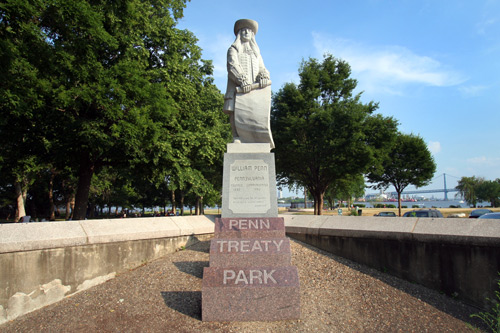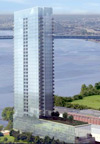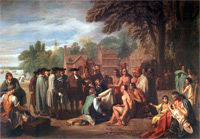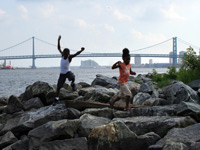
If Philadelphia is our religion, then Penn Treaty Park is our Holy Land. Having lived on South Street, within a couple blocks of the Schuylkill River and its park,
Doobies and the Sidecar, for four years (and on Fitzwater for two before that), leaving G-Ho and its walking distance to Center City's everything
was a difficult decision. Knowing the Delaware had no trail like the Schuylkill's (it's coming, slowly but surely, bit by bit), making the investment
and move to Fishtown was a tough decision . . . a tough decision that was a lot easier after a couple bloody marys at Johnny Brenda's and a session on the rocks at
Penn Treaty Park.
 Penn Treaty Park has gotten a lot of attention over the last few years, and for most of the right reasons. Sugar House is moving a lot of dirt just a couple parcels
downstream; the prospect of its traffic on Delaware Avenue and the impending rebuilding of the Girard Avenue interchange of I-95 have created concern for the Park's
many regulars. PECO's partial demolition continues right now, right next door on the upper portion of its Delaware Station, the beautiful, massive relic of
power designed by John T Windrim that needs to stay there. Next door on the other side, a 30 story condo tower is proposed for a circa-2005 market. From the
Penn Treaty Tower web site, which has lots of smiling white people and which makes no bones about wanting
to flip the property, going as far as mentioning "C3 zoning for a high-rise real estate opportunity":
Penn Treaty Park has gotten a lot of attention over the last few years, and for most of the right reasons. Sugar House is moving a lot of dirt just a couple parcels
downstream; the prospect of its traffic on Delaware Avenue and the impending rebuilding of the Girard Avenue interchange of I-95 have created concern for the Park's
many regulars. PECO's partial demolition continues right now, right next door on the upper portion of its Delaware Station, the beautiful, massive relic of
power designed by John T Windrim that needs to stay there. Next door on the other side, a 30 story condo tower is proposed for a circa-2005 market. From the
Penn Treaty Tower web site, which has lots of smiling white people and which makes no bones about wanting
to flip the property, going as far as mentioning "C3 zoning for a high-rise real estate opportunity":
Designed for success in tourism and retail, Penn Treaty Tower is also a prime residential opportunity for suburban couples and families who want to
remain off the city street grid but close to all the benefits of urban life.
Fortunately for our city so entrenched in its own history, Penn Treaty Park predates luxury towers that won't happen and slots barns that are the opposite of luxury
and interstate highways being built and rebuilt. In fact, our worship of Penn Treaty Park predates Penn Treaty Park itself.
Looking backwards through history, we pass the city's tercentennial celebration in 1983, the general acceptance of Lower Kensington's renaming of Fishtown, the
park's official dedication in 1893, the placing of the granite obelisk -- the first public monument in Philadelphia -- in 1827, and the great lightning strike of
1810. That lightning strike destroyed the elm tree which was the alleged site of the treaty of friendship between Penn and his Quakers and Tamanend and his Lenni
Lenapes.
 That 280 year old elm tree was, one could say, martyrized by that lightning strike. Descendants of the tree exist from seeds planted at Pennsylvania Hospital, in
Haverford, and indeed at Penn Treaty Park. The legendary tree and the legendary treaty are depicted in Benjamin West's painting Penn's Treaty With the
Indians. The oil on canvas, measuring 75½" x 107¾", was commissioned by Thomas Penn, son of the founder, in 1771. On the eve of the American
Revolution, it's ironic that West, himself a Quaker, was stationed in London, where he'd moved in 1763, never to return to his native Pennsylvania. In fact, the
American was appointed official history painter to Britain's King George III. (Michael Lewis, Mark Hain: Pennsylvania Academy of the Fine Arts: 200 Years of Excellence, 1805-2005.)
That 280 year old elm tree was, one could say, martyrized by that lightning strike. Descendants of the tree exist from seeds planted at Pennsylvania Hospital, in
Haverford, and indeed at Penn Treaty Park. The legendary tree and the legendary treaty are depicted in Benjamin West's painting Penn's Treaty With the
Indians. The oil on canvas, measuring 75½" x 107¾", was commissioned by Thomas Penn, son of the founder, in 1771. On the eve of the American
Revolution, it's ironic that West, himself a Quaker, was stationed in London, where he'd moved in 1763, never to return to his native Pennsylvania. In fact, the
American was appointed official history painter to Britain's King George III. (Michael Lewis, Mark Hain: Pennsylvania Academy of the Fine Arts: 200 Years of Excellence, 1805-2005.)
West's enormous painting is on display at the PAFA museum, as part of its permanent collection in the
Art of the Colonial Period room. It depicts the treaty of amity with Penn, his Quakers, the Lenapes and merchants under the elm on the banks of the Delaware
River in what was then Shackamaxon. At the time of Penn's arrival, the land was occupied by Thomas Fairman (who was mentioned as owner in
the recent essay about Petty's Island), whose wife Elizabeth had purchased it from the Swede Lasse
Cock. (Fishtown Architectural and Archaeological Industrial Survey.) Penn
actually stayed with Fairman (as did his surveyor Thomas Holme and others in his entourage) before Pennsbury Manor was built.
West's Penn's Treaty, generally accepted as more allegorical than historical, inspired similar artworks portraying Penn and the Lenapes, including those by
Edward Hicks (1840) and Currier & Ives (1860s).
* * *
For as skeptical as Philadelphia can be, it seems that we're pretty confident that the treaty did happen, while doubt seems to come from outside historians. Since
there was no written record of it, it cannot be proven true. That it was not written is part of the legend; had it been, the French Enlightenment philosopher
Voltaire would have never opined that it was "the only treaty between those people that was not ratified by an oath, and [therefore] that was never infringed."
(That quote appears in a number of different phrasings, but that one is from Quaker.org. It also
appears at USHistory.org, as fine a source on William Penn as any.) Kenneth Milano's
excellent Remembering Kensington & Fishtown has a three
page chapter entitled "Did William Penn's Treaty with the Lenni-Lenape Take Place?" Citing testimonies from the period and the fact that the British General John
Simcoe, whose men were quartered at Kensington the same winter Washington's were in Valley Forge, posted a sentinel to protect the old elm tree from being chopped
for firewood, Milano's tone tends to side with those who believe the treaty as truth:
The living testimonies of Judge Peters and his friend Conyngham [who recounted swimming near the heralded elm tree in their youth], their conversations
with the aged Benjamin Lay, the actions of Simcoe and West's
memorial painting, as well as the number of historians who recounted Penn's Treaty, all support the contention that the treaty indeed took place at
Shackamaxon.
Penn Treaty Park's survival through, or rather, birth from, the industrial revolution is itself worth its own exhibition at the park. The web site PennTreatyMuseum.org contains an extensive history of the park with rare photos, including some of the
late municipal Pier 57. (PhillyHistory.org has some photos of this as well HERE.)
Modern day Penn Treaty Park has no pier, but it may again some day. The Friends of Penn Treaty Park is
in the process of executing a master plan for its future. Win Akeley, the organization's president, says, "we put out our RFP
(request for proposals) over the summer, and eight proposals were sent back. It's just [early in the] process right now," he says, explaining, "but it's very much
going to be a public process, with at least three or four community meetings." Kellie Gates covered the Friends' third annual fundraiser, Champagne in the
Park, last month for Plan Philly.
 While the park is already well used and improving -- it is ADA compliant and new bike racks were installed over the summer, for example -- there is still room for
further improvement. The reintroduction of the pier is one possibility; a public boat dock is another. Still another could go a long way to allowing people to grow
literally more in touch with the river: replacing the boulders along the banks with softer sand.
While the park is already well used and improving -- it is ADA compliant and new bike racks were installed over the summer, for example -- there is still room for
further improvement. The reintroduction of the pier is one possibility; a public boat dock is another. Still another could go a long way to allowing people to grow
literally more in touch with the river: replacing the boulders along the banks with softer sand.
All in due time. In the meantime, Penn's Treaty lives on at the park named for it, and in the rotunda of the US Capitol, and at an Allentown-based insurance company, and at the middle school six blocks away from the place it was named for.
If it's been a while since you've been there, or if you've never been there, do yourself a favor and grab a whiz wit across the street at Johnny's Hots (Philly
Mag's Best of Philly 2006) and wash it down with
something you packed down at the river's edge. The view of the river, the Ben Franklin Bridge, and the boats passing by are better nowhere in Philadelphia.
For an essay of photos from Penn Treaty Park (36 total -- about 6.5M, so just give it a second to load), please click
HERE.
–B Love
|